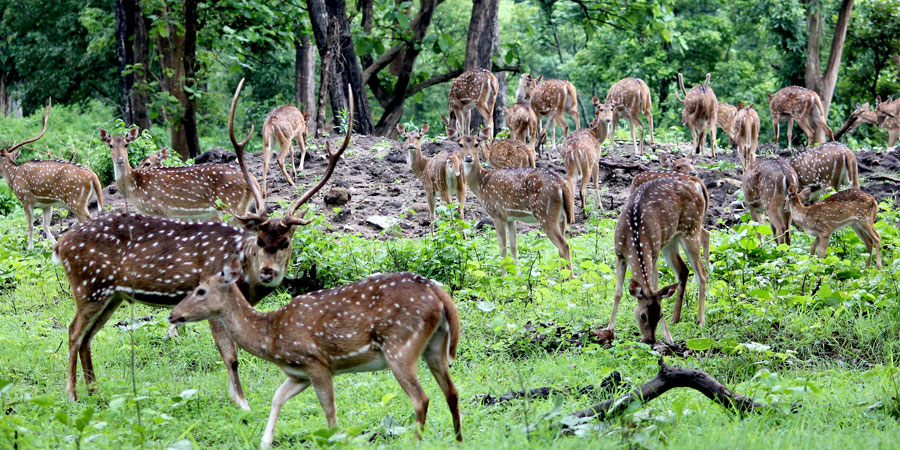
Bardiya lies in Bheri zone in the mid western region of Nepal. It covers 2025 square kilometers and lies west of Banke district, south of Surkhet district, east of Kailali district of Seti zone. To the south lie Uttar Pradesh, India; specifically the Lakhimpur and Bahraich districts of Awadh. Most of Bardiya is in the fertile Terai plains, covered with agricultural land and forest. The northernmost part of the district extends into the Churiya or Siwalik Hills. Bardiya National Park covers 968 km2 occupies most of the northern half of the district. This park is the largest undisturbed wilderness in Nepal's Terai. It provides forest, grassland and riverine habitat for engendered mammal, bird and reptile species. More than 30 species of mammals and more than 250 of birds have been recorded. Most people living in this district are farmers. The district headquarters Gularia lies on the Babai River. The Karnali, one of Nepal's largest rivers, divides into multiple branches when it reaches the Terai. The westernmost branch forms the boundary between Bardiya and Kailali districts. An eastern branch is called the Geruwa. The endangered Genetic dolphin was often seen in its waters, but populations have been declining
Fly or Drive from Kathmandu/ Pokhara to Chitwan we meet in bus station or at the Bharatpur Airport then transfer to the resort/hotel. Refreshment drink and briefing about the accommodation and the facilities. After lunch our manager will brief you about the program of the following days. After a short rest, visit to the Tharu village and the National Park Visitors Center.
| Time | Activities |
|---|---|
| 13:00 | Lunch |
| 15:30 | Crocodile breeding center/Tharu village/Jungle Jeep drive |
| 17:00 | Sunset view from Riverbank |
| 18:30 | Slide show/Tharu stick dance |
| 19:00 | Dinner/Culture program |
In Bardia National Park, you enjoy a full day of Wild-Life Safari activities such as: Elephant back safari, Nature walks, Canoe trip or boat ride, Jeep drive in the Deep forest, Elephant bathing, bird watching, Tharu Village tour etc. as per time permits. Trained local naturalists and guides will guide all to you. Animals and birds to be seen are rhinoceros, crocodiles, bear, monkeys, several species of deer, pythons, peacocks, hornbills, woodpeckers (amongst more than 400 species of birds recorded in the park).
Time Table and Program
| Time | Activities |
|---|---|
| 05:30 | Wake up call |
| 05:45 | Tea/Coffee |
| 08:00 | Breakfast |
| 09:00 | Canoe ride/elephant briefing / swimming and bath |
| 13:00 | Lunch |
| 15:00 | Elephant ride / nature walk / visit to observation tower / Canoe ride |
| 18:30 | Tharu Stick Dance/slide show |
| 19:30 | Dinner |
Early morning fly from Kathmandu to Nepalgunj, we will welcome you at Nepalgunj airport then transfer to the resort/hotel. Refreshment drink and briefing about the accommodation and the facilities. After lunch our manager will brief you about the program of the following days. Visit to crocodile breeding center and tharu village & Jungle drive. You enjoy dinner, in the evening; enjoy cultural programs conducted by Tharu, community of Terai. You stay overnight at camp or lodge.
Time table and programArrival pick up from bus station or airport transfer to hotel and welcome
Briefing by the Lodge manager
Lunch
Crocodile breeding center/Tharu village/Jungle Jeep drive
Sunset view from Riverbank
Slideshow/Tharu stick dance
Dinner/Culture program
Bardiya lies in Bheri zone in the mid western region of Nepal. It covers 2025 square kilometers and lies west of Banke district, south of Surkhet district, east of Kailali district of Seti zone. To the south lie Uttar Pradesh, India; specifically the Lakhimpur and Bahraich districts of Awadh.
Most of Bardiya is in the fertile Terai plains, covered with agricultural land and forest. The northernmost part of the district extends into the Churiya or Siwalik Hills. Bardiya National Park covers 968 km2 occupies most of the northern half of the district. This park is the largest undisturbed wilderness in Nepal's Terai. It provides forest, grassland and riverine habitat for engendered mammal, bird and reptile species. More than 30 species of mammals and more than 250 of birds have been recorded.
Most people living in this district are farmers. The district headquarters Gularia lies on the Babai River. The Karnali, one of Nepal's largest rivers, divides into multiple branches when it reaches the Terai. The westernmost branch forms the boundary between Bardiya and Kailali districts. An eastern branch is called the Geruwa. The endangered Genetic dolphin was often seen in its waters, but populations have been declining.

The Bardia National Park has a sub-tropical monsoon climate with three distinct season in the annual cycle: hot season (march- June), Monsoon (July- October) and winter (October- February), each providing a unique experience. The weather is dry from October through early April with warm days and cool and pleasant nights. The absolute maximum temperature of 41 C in May and minimum temperature of 31 C in Jan-Feb. The hot sticky days give way to the monsoon rain that lasts until September.